Being able to see your surroundings is useful when cycling. Unfortunately, as any cold weather, glasses-wearing cyclist knows, it is is not always easy. When the temperatures are low enough to require you to cover your face, your scarf, balaclava, etc. directs your moisture laden exhalations up to condense on your glasses, fogging them. Instant white-out! In extremely cold weather (-20C for instance) it is almost impossible to avoid. Last winter, I tried a variety of solutions with varying effects. On the very coldest of days I resorted to finishing my commuting ride without my glasses. This was not ideal. However, this year I have finally solved the problem.
The basic idea is to direct your breath somewhere other than upwards. To do this I am using a half-mask respirator with detachable filters. This is a commonly available bit of safety equipment available at any hardware store. The one I am using is a 3M 6000 series mask. I’m using this model because it’s the one that I already had in the house. It is cheap, with online prices ranging from $6.00 to $16.00. The respirator is designed to snugly hug your face and direct your breath solely through the filter openings. The 3M 6000 has the air intakes on the sides of the mask and the outlet on the front. For our purposes, we want to modify this, making the side openings the outlet, so as to direct your breath away from your glasses. There are cold-weather respirators that are already designed to do this, and would likely work perfectly without modifications. I haven’t tried them. The changes I have made to my mask are reversible, so after the winter I’ll still be able to use it as a respirator.
You will also want to be able to cover the rest of your face. In my case, I have cycled in temperatures as low as-32C, and have a strong motivation to cover every exposed inch of skin. For a face covering I am using a neoprene/fleece mask. It is thin, insulating and stretchy. I bought mine last year at Army & Navy for $10.00. MEC has a slightly better version for $32.00. For the purposes of this project, you could likely use whatever face covering you already have (scarf, balaclava, etc.).
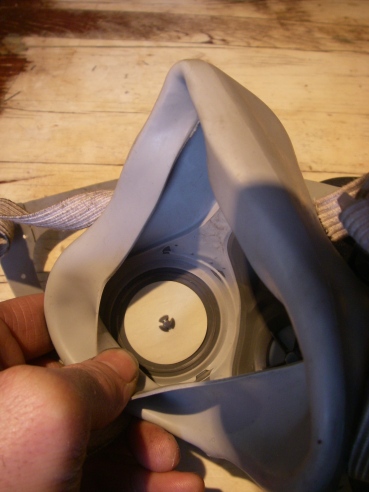
There are little elastomer disks that normally prevent air from exiting the side holes. Remove these. If you are carefull and don't damage them they may be reinstalled if you want to use the mask as a respirator again.

The air normally exits from the front. Block this. I am using a scrap of bubble wrap and packing tape. It's ugly, but it works, and in any case it won't be visible when you are finished.

Next, cut two appropriately placed holes in your face covering and fit it over the respirator, with the side hole exposed.

Twist the locking tab onto the respirator. This will securely attach the face covering to the respirator. It may be a tight squeeze, depending on the thickness of the face covering you are using.
At this point you are pretty much finished. The mask / respirator combo may be used with good results as is. I have tested it at -20C in this state and it worked fine. However, at lower temperatures I found that too much cold air blew in directly though the side holes. To prevent this I made a couple of baffles out of some plastic packaging. This was intended to be a temporary measure until I found a better solution, but it has worked so well that I haven’t bothered to replace them.

I then just hooked them under the locking tab. They quite effectively direct the exhalations backwards while preventing too much in-rushing cold air.
In this configuration I have used the mask on a 45 minute ride when the temperature was -32C with a windchill of -44C. I was perfectly comfortable and enjoyed fog free vision. On those extremely cold days, I wear cheap ski goggles that are allegedly anti-fogging. Last year, they still fogged up somewhat. With this mask there was no fogging. It is possible that at these temperatures your glasses will fog INSIDE the goggles while the goggles themselves remain clear. This is not due to your exhalations and the mask/respirator will not help. What does work is applying a drop of dishwashing liquid on both sides of your glasses lenses. Lightly buff the lenses until they are clear. A thin, invisible film of soap will remain that will prevent fogging.
Finally, the following photos show the arrangement of coverings I use to ensure total skin coverage.

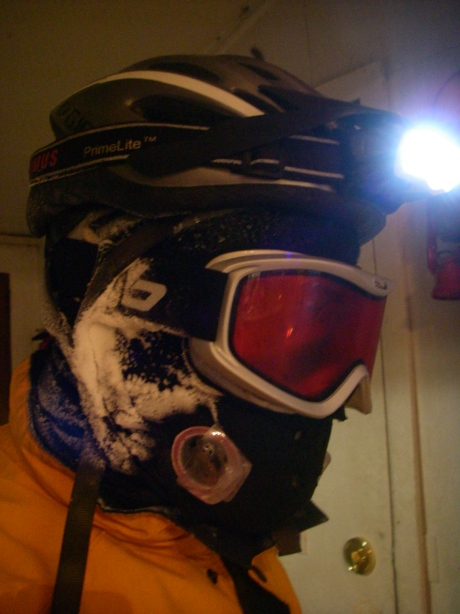






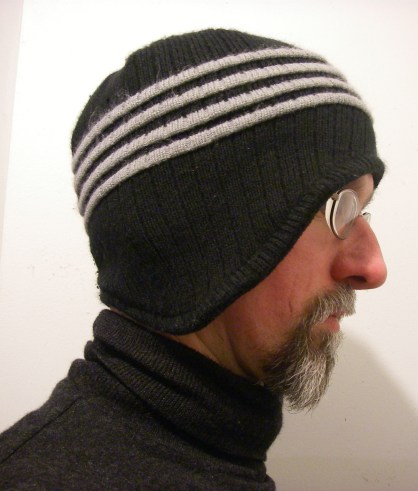

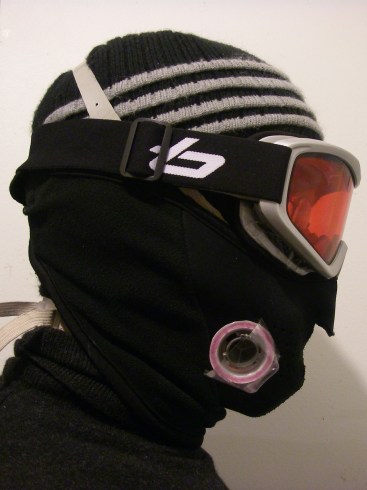
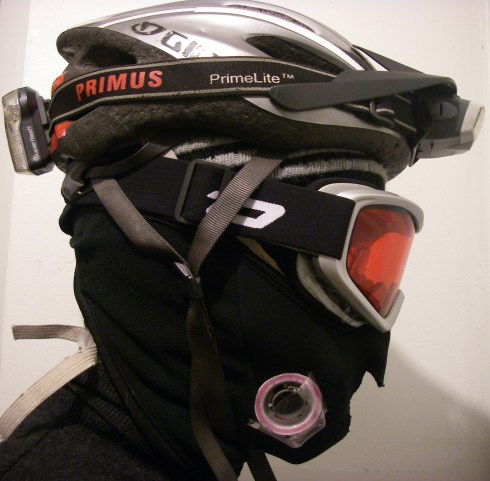
You have some great ideas, I may try some of it at some point but here in the UK we’ve had a fairly mild winter so far but last year was quite cold.
LikeLike
Thanks! Our winter was quite mild as well, until last week.
LikeLike
Great stuff. Even though we don’t have your low temperatures, I wear a ski mask to protect my eyes when it is chilly and because it is much easier to wipe rain off on the go than glasses. The washing up liquid tip is good.
LikeLike
Thanks! The ski mask really is a useful bit of equipment. I wish they had not been out of stock of the clear lenses when I bought it. The tinting is quite unnecessary during my predawn commute.
LikeLike
That’ll come in handy for me next winter, when I have my recumbent tadpole. Biking on my bent just isn’t an option in our winters, which were, incidentally, mild until a week ago. Thanks for the tip!
LikeLike
Thanks! I hope it works for you.
LikeLike
That is some serious cold you’re mucking about in, but I don’t have to tell you that. At those temps, frostbite occurs on exposed skin in five minutes. I’m glad you got the headgear working well, but I’d be very careful about stripping off gear should you overheat. Again, being a Canuck you already know this, but I feel compelled to share my hard-won experience with extreme cold in Fort Drum, NY (what you call, The South!).
LikeLike
I’m always keen to hear tips as all information may prove useful.
I am very much getting from point A to B in those conditions and don’t shed layers until I’m back inside. Except for my mittens (that I wear over another pair of gloves) when I need a bit of momentary manual dexterity.
LikeLike
You should seriously look in to patenting and producing this. That’s pretty clever
LikeLike
Thanks. Some products similar to this already exist but I am too cheap to buy them. Of course, mine may work better…
LikeLike
Totally awesome! They say imitation is the sincerest form of flattery…

I had a older cheapy dust mask (I think it was 3 for $6) kicking around that had a breath valve and I found that it’s two pieces that just snap together and pinch the fabric of the dust mask to hold itself in place. With a small screwdriver I was able to separate the two pieces of the valve. So I cut a small hole in my MEC oust bandanna stretched it around the back piece of the valve and then the front piece snapped on without any problems. I thought the white plastic stood out too much so I used a little bit of touch up paint I had on hand to paint it blue so now it looks a lot like the lid off a milk jug haha.
LikeLike
Cool! You’ll have to let me know how it works for you during the next cold snap.
LikeLike
Works like a charm, fog free at last!
LikeLike
Splendid!
LikeLike
I have anti-fog drops for scuba that work remarkably well on glasses. Won’t help for the exhalation, but would for the glasses under goggles. I find them easier to apply than dishwashing liquid and they will hold up to some rain. I’ve had the same little bottle for years as a little goes a long way. I carry the bottle when I hike in case I unexpectedly hit fogging conditions.
LikeLike
That’s a great tip. Thanks!
LikeLike
Hi there, this will be my first winter of cycling. As you are something of a Winter Wizard, do you have any suggestions for pogies or moose mitts?
LikeLike
I haven’t used them myself so I can’t make a reccomendation easily. On the coldest days I wear a normal pair of winter gloves inside a larger pair of ski-doo type mittens. I think both pairs together cost me about $15.00. I have also found that my hands and feet are warmer if I keep my core toasty as well.
LikeLike
I’m gangly so my extremities always freeze no matter my core. When I make and use the mask, if it’s satisfactory, do you mind if I repost it?
LikeLike
Please do!
LikeLike
What size 3M mask did you use?
LikeLike
I don’t have it at hand right now but I beleive it was a medium.
LikeLike
Dude, you rule! I’ve also been trying to get rid of fogging problems since last winter. I wear glasses too, so eventually bought Scott OTG goggles. Awesome idea! My goggles don’t fog up but my glasses inside do, so I may have to try this one day. nice DIY write-up!
LikeLike
Thanks! If you don’t have to cycle in the EXTREME cold, the dishwashing liquid trick might solve problem the glasses fogging inside the goggles.
LikeLike
Brilliant! I had been searching for a similar solution, and had independently thought about a respirator. But I couldn’t quite come up with a way to integrate it with a warmer/wraparound. Fortunately found your post, and came up with an analogous solution via a Cold Avenger mask that leaked air/moisture into my glasses. Worked perfectly!
I also just plain appreciate the geeky tinkerer spirit, which I think we share ….
Best,
– Eric
LikeLike
Thanks! It’s been working for me for several years now. Hope your setup does well for you.
LikeLike